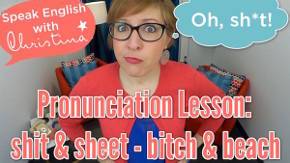
Stop Translating in Your Head & Learn to Think in English
Many Speak English Ambassadors have told me “When I speak English, I feel like I translate in my head. It makes me slow. I’m not spontaneous. I listen and by the time I translate to understand, the conversation continues, and I’m lost.”
This week’s lesson is going to help you stop translating in your head, so you can become more fluent more quickly.
Why do you translate in your head?
Here’s a quick explanation: Your native language is not English. If it was, you probably wouldn’t be watching this lesson.
So, in your brain, there are 2 (or more) languages. Think of these languages as muscles. Let’s say your native language is French. You’ve been exercising your the French muscle in your brain for decades. So it’s much stronger, like Arnold Schwarzenegger, but without the Austrian accent.
But you’ve only been exercising your English muscle for a few years, and probably not consistently.
A trip to the USA here, a few meetings in English there, maybe emails in English a few times a day. So, the English muscle in your brain is a little like
Your English muscle has a lot less training than your French muscle. So you need to start working out your English muscle. Immerse yourself in English
To stop translating in your head, you need to get away from using your native language to understand and speak English. That means, immersion.
Not necessarily taking a month to go live in an English-speaking country. That’s not always feasible. But you can create your own immersion. Here’s how.
First, start using an English only dictionary when you need to find the definition of an English word. Maybe today, you use Google Translate, or WordReference to find translations.
Let’s stop that! Here’s a new tool for you: The Merriam Webster Learner’s Dictionary. It’s an English-English dictionary online.
This way, when you hear or see a new word in English, you can look for it in the monolingual dictionary. You’re learning how to describe a word in English, how to think about a new word in English, and you’re getting more exposure to English by reading the description.
That’s a little exercise for your English muscle!
Start Thinking in English
What if you want to practice English but you have no one to practice with? Start by thinking in English to yourself.
I can hear your hesitations now: “Yeah, but no one is there to correct me”!
That’s ok, honestly. You don’t have to use perfect grammar 100% of the time.
If you did, it wouldn’t sound very natural, actually. We native speakers mess up our own language so much!
It’s better to get the practice in English by thinking in English and making mistakes than to not think in English because you’re worried about mistakes.
Correcting yourself
While you’re thinking in English, if you’re not 100% sure about the language you use, make a note of it somewhere and check later. You can use a little language notebook. Or note it on your smartphone, send an email to yourself, whatever system you use to remind yourself of things to do.
Note questions you have about English. Literally write “What is the word for “une trousse”? And then look for the word later when you have time.
This also works well for when you’re watching movies, TV series or reading. Don’t try to note every new word, because that will take the fun out of it.
But if you hear or read the same word a lot of times, and you don’t know what it is, just take 30 seconds to note it somewhere and look for the definition later, preferably with your monolingual online dictionary.
Practice Speaking in English
The next step is to speak in English to practice…speaking. Yes, talk to yourself. Out loud. Preferably when you’re alone, but you can do it around other people. They might think you’re crazy, but hey, at least you’re doing something.
Don’t be afraid to talk to yourself. Describe the things around you, play little scenarios in your head, ask questions to yourself in your head. When I’m learning a language, this is my favorite technique.
Watch the video of this episode:
Practice speaking with our Conversation Club
Of course, the best thing is to practice with a speaking partner. And I make it easy for you to find a partner.
How?
In my Faster Fluency Conversation Club, you can connect with other members of the Speak English Community, and teachers, for regular conversation practice sessions each week.
Plus, you get activities to increase your vocabulary, a podcast to increase your listening skills, the transcript (more vocabulary!), and of course the confidence and fluency that comes with regular practice.
And for a limited time, you can save -40% off your first month of membership with the code FFCC40
Click here to take advantage of this special offer and become fluent faster
Now what about you?
What other techniques or tools do you use to do English regularly?
Share them in the comments because it can really help other members of the Speak English community.
And after you join the Faster Fluency Conversation Club, come back and tell me how it’s helping you. I love to hear about your success in English, because your stories are so inspiring for me and the entire community!
Have fun,
Christina

<script async data-uid=”91ec263eec” src=”https://f.convertkit.com/91ec263eec/c9f3802904.js”></script>
More English lessons...
Click the image to see the lesson









And listen the radio all the time ! It’s what I do as soon as I jump in my car. I love NPR and I learn some new stuff every day !
I love NPR! I used to listen to it all the time when I was in the US. Definitely good for learning spoken English, and for just learning about interesting subjects!
Thank you so much for the lesson!
It was really encouraging and helpful. To immerse myself in English, I also listen to the English podcast while driving or cooking. I put American TV dramas on when I have lunch by myself at home (Sorry if it’s a bad manner).
I’m looking forward to your next lesson 🙂
Hi Kumiko! Podcasts are such a good idea, and if you’re having lunch at home, it’s a great idea to use that time to do some English at the same time. As you say, the more you immerse yourself in English, the better!
I do pretty much the same as Isabelle and Kumiko but with audiobooks. Since my childhood I love reading but I do not had the time. Now, I listen a book and in the same time, I listen english. To learn english, we have to practice everyday. To practice everyday, we must doing something pleasant
I totally agree with you Romain! You’ll never become fluent if you only do an hour a week. You really have to immerse yourself and audiobooks, podcasts, the radio, TV, etc. are great ways to do that. Plus, technology makes it sooooooo easy nowadays! What are some good audiobooks that you could recommend to us?
Thanks for the lesson.
I didn’t really learn english at school (English education in France is not the best 😉
So i had to learn by myself. I have some advices to add, some things i did, and I’m still doing.
I set all my devices in english (smartphone, computer, tablet). That way your learn more and more vocabulary. And you immerse yourself (even in France).
All TV shows and Films I’m watching are in English (Original version), with french subtitles (now I can watch movies with english sub). You’ll improve your understanding with many different accents and way to speak. You’ll learn a lot of expressions ! And it’s fun…
I’m reading a lot of articles in english (about whatever I like, there are so much articles in english compared to french).
I like to sing. It’s helping me about my pronunciation, vocabulary, oral fluency,…
And finally, It’s been 2years since I met english-speaking friends (from Italia, India or France). The best way to improve your english is to practice with people who speak really good english.
Practice Makes Perfect.
Hi Christina!What’s the better way to grow in English when we’re on intermediate level,i.e.,to grow in vocabulary,grammar and to speak fluent English?You know I mean how should study towards be fluent?Do you understand me what I wanna mean?
Hi Carlos, good to see you here! And that’s a great question. There’s actually a video about the subject: https:/blog/how-to-become-more-fluent-efficiently/ I think this will help you! And if you have more questions about that one, just let me know!
I read this article thinkind in english thanks
I leave in the pacific ilands and i want to known what about the hours for lessons conversations
Hi Peli,
I’m not sure exactly what time zone you’re in, but you can use this time zone converter to convert the conversation session times to your local time.
The sessions are at these times, CEST (France time):
Mondays 18:00-19:00 CEST
Tuesdays 15:00-16:00 CEST
Fridays 12:30-13:30 CEST
And if 1-2 of those sessions work for you, please join us in the Conversation Club! We’d love to have you!
hello
your english is American or British ?
American! I’m from Mississippi, in the USA!